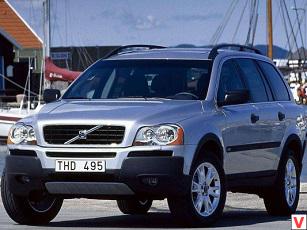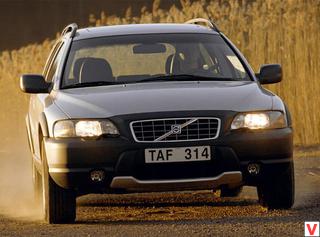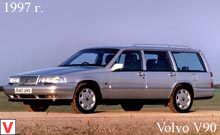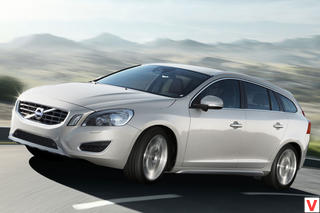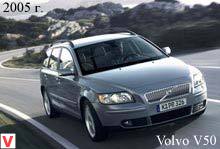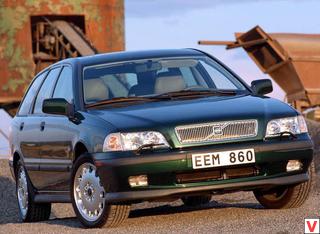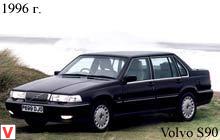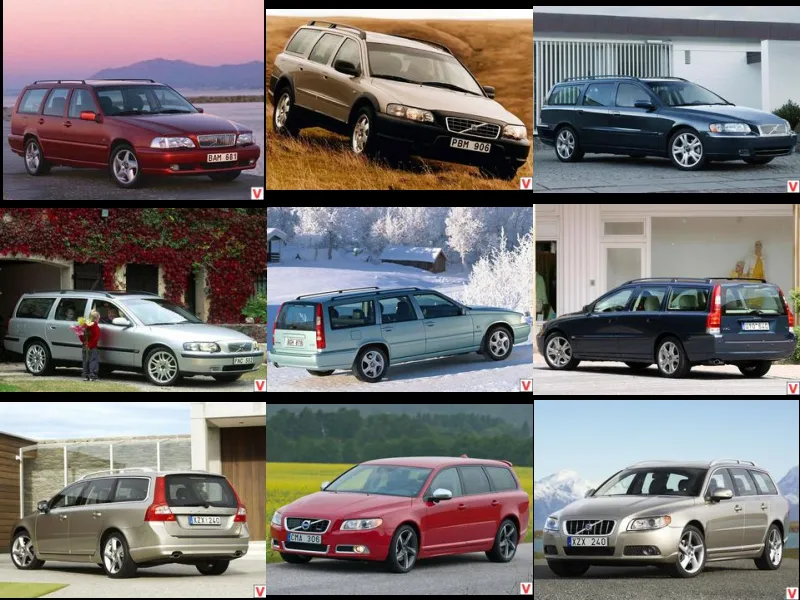
In 1997, Volvo introduced a follower of the 850 Wagon, a new-generation V70 car. "V" - Versatility (something versatile, universal). The car has all-wheel drive versions: the standard V70 AWD and V70 XC - with increased ground clearance and slightly modified body design. Choosing a VolvoV70 AWD, in addition to a convenient wagon, the owner also gets four-wheel drive. Volvo V70XC, in the presence of all-wheel drive, increased ground clearance and sophisticated style, copes with the road not only on difficult country roads, but also on high-speed open highways and in the city. The back of the V70 inherited almost unchanged from the 850th. Taillights occupy the entire height of the body.
Door handles and plastic moldings painted in body color. Volvo V70 - a car in which there is enough space for the whole family. Maximum practical in everyday use. Ideal for commuting, leisure and traveling. The seats provide comfort even on the longest rides.
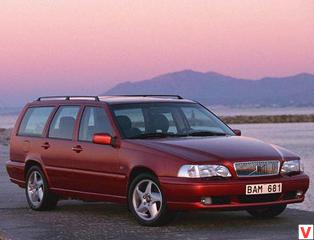
Equipped with electric heating and have armrests on both sides. Plus, convenient adjustment of the position and tilt of the back, height, as well as support for the waist and distance to the pedals. The luggage compartment in this version depends on the method of transformation of seats. The standard value with 5 free places (420 liters) can be increased to an impressive 1580. You can fold backs and pillows 1, 2 or all 3 seats in the back row. Then the reverse side of the backs forms a single plane with the luggage compartment floor. The car additionally provides for the possibility of folding the backrest of the front passenger seat.
When transporting bulky cargo, you can install a mesh partition. In 2000, the second generation Volvo V70. At the same time, the Volvo Cross Country car appears. Volvo V70 XС Cross Counry refers to the versatile all-rounders. In fact, this is an ordinary passenger car with a “universal” body, and outwardly it differs from monoprivodal models only in increased clearance and a powerful plastic body kit “in a circle”. Cross Country was created on the basis of the usual all-wheel drive station wagon Volvo V70 and inherited from it all units and components.
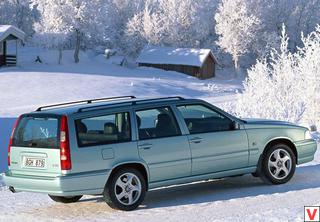
This means that the Cross Country is a normal front wheel drive car for most of its life - in normal conditions, 95% of the torque is transmitted to the front wheels. This solution allows you to achieve, firstly, low fuel consumption, and secondly, almost "front-wheel drive" habits when driving. Volvo's proprietary all-wheel drive system allows you to change the percentage of the energy transmitted between the axles, and it does so in much greater limits than ordinary viscous coupling allows. For example, if necessary, the same 95% of torque can be transferred to the rear wheels, if their coefficient of traction is much higher than that of the wheels of the front axle.
This energy distribution scheme allows the Volvo V70 XC Cross Country to move where a car with a less advanced all-wheel drive system is stuck. Below the engine and transmission are closed with a powerful metal shield, unpainted bumpers are not afraid of scratches and chips. From Volvo Cross Country simply blows reliability and endurance. The car looks massive: huge wheels and powerful bumpers unobtrusively hint at great potential; The powerful, pronounced side line not only carries an aesthetic load, allowing you to accurately identify the Cross Country, but also perfectly protects riders from the effects of side impacts during an accident.
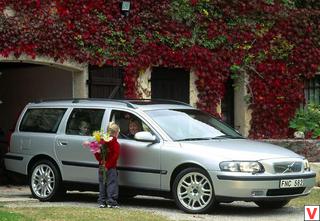
In the list of standard Volvo V70 XC Cross Country equipment there are not only traditional front and side airbags and ABS with electronic brake force distribution, but also anti-skidding system and proprietary "Volvo" whip-strike protection system called WHIPS. Protective inflatable curtains on the windows complete the picture. And although the Cross Counry salon is almost the same as the S80 and V70, on a single platform with which it is built, it still has several original features. Take at least a three-piece back sofa.
Given the more versatile nature of the all-wheel drive car, the creators made sure that the interior of the car also became more functional. Unlike most station wagons, not even all-wheel drive, the back seat in the Volvo Cross Country can be split into three parts, in the proportion of 40:20:40. This means that if you only carry two passengers, then the middle part of the back sofa can be folded, thus forming the choice of either an additional luggage compartment or a place to install a special portable refrigerator, offered as additional equipment.
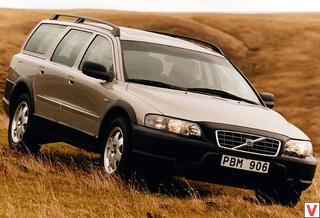
Three-layer side windows and excellent sound insulation dampen absolutely all sounds. Volvo Cross Country has excellent visibility: massive-looking racks are turned towards the driver in such a way that they do not overlap the view, and secondly, huge side mirrors help a lot in the city. Cross Country is equipped with a turbocharged 200-horsepower engine. On request, Cross Country is equipped with an automatic five-speed “Geartronic” gearbox, which allows the driver to choose the gears and the moment of their switching. In the second-generation V70, a new generation of gasoline engines is being installed - five-cylinder engines of 2.4 liters, with a capacity of 170, 200, 250 hp.
Volvo V70 is a true leader in terms of dynamics and environmental parameters. The car is provided with an environmental declaration, which describes in detail the environmental impact of this model - at the stages of production, operation and processing. The Volvo V70 has several original features that “care” about the environment both inside and outside the car. Volvo motorists have achieved cleaner emissions and reduced fuel consumption while driving on the highway through the use of better quality materials and design changes that increase the temperature of the exhaust gases.
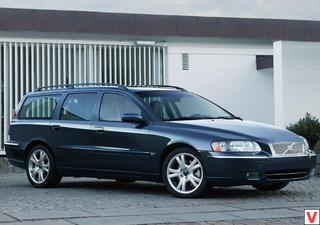
The variant version of the Volvo V70 with improved performance is designated T5. Under its hood is a five-cylinder 2.3-liter turbocharged engine. It develops 250 hp. (242 to SAE) and a torque of 330 Nm. Fuel consumption is only 9.3 liters per 100 km according to EC standards in the combined cycle. Volvo V70 is equipped with one of four engines at the choice of the buyer. All of them - five-cylinder.
In addition to the T5, a 2.4-liter engine with a low-pressure turbine, a 2.0-liter turbocharged engine (for some markets only) and a 2.5-liter turbo diesel with direct injection are offered. The most modern all-wheel drive with viscous differential and traction control system TRACS provides exceptional stability in all conditions. The ground clearance is increased to 209 mm. The car is equipped with the most modern chassis with Multi-link type suspension, powerful brakes with ABS, STC, DSTC, EBD systems. Powerful and reliable 2.4-liter five-cylinder engine with turbocharging, 200 hp makes the XC70 particularly temperamental.
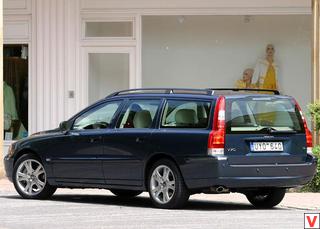
On the Volvo V70 XC and Volvo V70 AWD, the distribution of torque between the wheels occurs automatically - without any intervention from the driver. With uniform movement, 95% of the tractive effort is transmitted to the front axle. The rear wheels are driven by a transfer case, propeller shaft and viscous viscous coupling. If the car is in heavy road conditions, most of the torque falls on the wheels that have the best grip on the ground. For example, if Volvo tows a trailer, the rear wheels will have more weight, which will also be offset by an increase in the transmission of torque to them. Finally, for more stable braking, the torque supply to the rear wheels is stopped.
The Volvo V70 inherits the carefully thought-out, safe design of the S80. Inflatable Curtain (IC) - a device that comes as standard. This original side impact curtain, built into the upholstery, is instantly inflated to prevent damage to the head as a result of a collision with the interior panels or another accident participant. IC protects passengers in front and in the back.
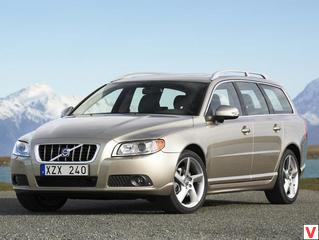
Two-threshold airbag - significantly increases the consistency of the seat belts and airbags. The sensor registers the impact force and adjusts the inflation of the cushion accordingly, at the same time coordinating this process with the operation of the seat belt. If the blow is not too strong, but still can cause injuries, the two-threshold airbag inflates by 70 percent. At the same time sitting in the car, especially those who are near the wheel or torpedo, are protected by a more careful way. With a sufficiently strong blow, the pillow is fully inflated. At the same time, the seat belt contributes to the overall protection.
During impact, the pretensioner selects the belt slack with maximum efficiency. Then the belt is slightly released to ensure a more gentle fixation of the person, and, finally, the airbag performs its final role in this sequence. The new Volvo V70 is also equipped with ISOFIX mounts of international standard for installing child safety seats. Volvo Cars Corporation is the first in the world to launch safe child seats with ISOFIX anchorages that are installed against the direction of travel. A safe child seat is essentially two seats in one. A smaller seat for babies up to nine months old with a carrying handle that makes it easier to remove it from the car.
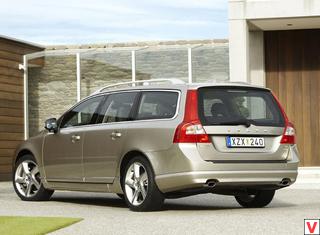
Larger seating for children from nine months to three years. It is equipped with an improved buckle for easy fit of the belt and is set in a special position for comfort during sleep. The latter function is for legal reasons not available in seats sold in the USA. Both seats are fixed on the frame, which, in turn, is fixed in the car by ISOFIX elements. The operation is quick and easy, which will appeal to all parents. The main advantage of ISOFIX - the system reduces the risk of improper installation of the seat. Of course, a safe child seat from Volvo Car Corporation is installed against the direction of travel.
In young children under the age of three, the head is relatively large, and the neck is not yet sufficiently developed. Therefore, there is a serious risk of injury or even death of the child when he is facing forward. Volvo V70 can be equipped with dynamic stabilization and traction control DSTC. This system keeps the car even on the most slippery road.
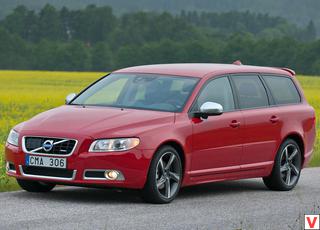
Gyroscopic sensor registers the mismatch between the turn of the steering wheel and the course of the car, that is, the beginning of a drift. The system brakes one or more wheels to adjust the course. DSTC is especially useful when the driver slows down dramatically during a forced maneuver. The system helps him to maintain control over the car while avoiding a collision. If desired, the Volvo V70 can be equipped with rain sensors that automatically turn on the windshield wipers.
The car also has many systems for the personal safety of the driver and passengers. For example, an outdoor lighting system. One touch of the keychain, and the Volvo V70 lights up several external light sources, including lamps in the lower edges of the rear-view mirrors, to illuminate the space around the car. Accompanying lighting.
Thanks to this feature, the space around the car remains lit for about 90 seconds after you exit it. There is also a sports version of the Volvo V70 R, equipped with a powerful 300-horsepower engine. This version even has a special engine compartment design. On the engine and the casing of the gas distribution mechanism is clearly visible the letter "R" of blue color - a characteristic sign of the series. The casing of the intake manifold is trimmed with aluminum and the “R” logo also stands on it. Aluminum cladding is also used for the air intake pipe coming from the turbo supercharger, which dominates the exterior design of the engine.
The engine on the Volvo V70 R is truly powerful, as evidenced by the following characteristics: five-cylinder, 2.5-liter capacity. The new in-line turbocharged engine, which was a continuation of the T5 series, is considered to be the most powerful in the Volvo engine range. The engine of a series R develops power in 300 hp (220 kW) at 5500 rpm, and the torque is 400 Nm in the range from 1950 to 5250 rpm. On the engine of the “R” series, a dual system of constantly variable valve timing (CVVT) is installed on the intake and exhaust ducts. The CVVT system regulates the valve opening parameters in accordance with the rotational speed and engine load.
This achieves a more efficient use of engine power, improves performance, reduces fuel consumption and reduces exhaust emissions. The design of the new six-speed manual gearbox provides reliable operation with an engine that provides high torque. The gearshift knob makes short fixed gearshifts, indicating a quick gear up. This allows the driver to make fast gear changes. The “R” engine of the series can be equipped with a five-speed Geartronic automatic gearbox.
This gearbox gives the driver a choice: Geartronic can work either automatically, or the driver can manually shift gears without the clutch pedal. The automatic box is endowed with an adaptive function: i.e. she monitors the style of driving and makes gear changes, adapting to the specific driver. In addition, Geartronic has a “sporty” mode: operating in this mode, the gearbox shifts at higher speeds and more often shifts to downshifts. According to the parameters of exhaust emissions, the engines of the “R” series meet the requirements of the American standard LEV I and the European standard Euro 4.
The Volvo V70 delivers powerful acceleration at low engine speeds, steady road holding, predictable handling, front-wheel drive and brakes for all types of road surface and unsurpassed safety. In the spring of 2007, the third generation of the Volvo V70 appeared. The drive version of the V70 XC from this year began to exist as a separate model (XC70). In the design of the car there have been big changes.
If the predecessors were based on the nodes of the model S60, then now the “donor” for it was the more prestigious and overall S80. Hence, the markedly increased dimensions of both the car itself and its internal space. Thus, the distance between the rear sofa seat to the backs of the front seats increased by 21 mm, and the width of the passenger compartment at the level of the front passengers' shoulders became more than 30 mm. Volvo station wagon trunks have always been famous for their spaciousness. The updated V70 is no exception.
Additional 55 liters in the luggage compartment compared with the previous version. The luggage compartment has a large number of brackets for fixing luggage, and for the convenience of moving objects there are special guides. The wide opening of the fifth door, which opens remotely, simplifies the loading of large items. The back sofa folds in parts in the proportion of 40:20:40. The Swedes have tried to give the appearance of new items swift features. The front lines have become less chopped. The long side glass of the luggage compartment does not make the “stern” heavier, but rather gives it some lightness.
In a word, it is very stylish and even with a certain touch of sportiness. The build quality is top notch and is quite consistent with the status of the “donor”. Many elements of the interior are well-known - this is the “suspended” center console, and the multifunction steering wheel, which moved from the last “eighty”. Good visibility is achieved due to the relatively narrow side pillars and low edge of the rear window. Depending on the V70 configuration, special fans can be built into the seats that lower the temperature of the upholstery.
The audio system is designed for the installation of a regular subwoofer. The cabin filter not only catches particles of dust, but also does not allow the penetration of unpleasant odors from outside. The manufacturer emphasizes the environmental safety of interior finishing materials, which, in addition, do not cause allergic reactions. In general, inside the "seventies" there is a concern of the manufacturer of its inhabitants. In the optional list there is a kit called “Clean Air”. When you unlock the car with the key fob, ventilation is automatically turned on. Airing occurs within about one minute if the temperature outside is above 10 degrees.
The system filters the air in the cabin, bringing it to meet the requirements of the Swedish Association for the Prevention of Asthma and Allergies. At the traditionally high level for the brand is the passive safety of the V70. A new technology of an inflatable curtain has been implemented, which has increased in length by 60 mm to protect children sitting behind. The WHIPS system, built into the seats, protects the passengers' necks from overload during a sharp impact, and the BLIS system warns the driver about being in the so-called dead zone of another car.
Adaptive cruise control allows you to choose the most appropriate speed in the range of 30-200 km / h. A special City Safety system tracks the distance to the vehicle in front. If it becomes critical, then for the start City Safety will increase the pressure in the brake line a little. If the driver of the V70 continues to ignore the traffic situation, City Safety will provide the necessary deceleration without his participation.
From the "older brother" V70 inherited not only the interior of the cabin, but also the suspension Four-C (the concept of constant chassis control). Automation constantly monitors the operation of the chassis and manages to reconfigure shock absorbers in real time. In some circumstances, the system allows you to achieve a smooth ride, while others - sporting tenacity. The driver needs only to choose one of the three buttons of the fixed suspension modes - Comfort, Sport and Advanced.
The latter is designed for high-speed driving. The second significantly adds stiffness to the suspension and makes the steering wheel sharper. The automatic release of the parking brake makes it easier to start on a slope (this is especially important when slippery). Expanded range of engines.
The car can be equipped with three petrol and two diesel engines: from 2.4 liters (185 hp) to 3.2 (238 hp). True, for Russia, the range of engines is more modest - the base 200-horsepower 5-cylinder with one turbine, then the "six" (3.2 l) and the 6-cylinder turbo engine of 3.0 l under the symbol "T6". By the way, for the "seventies" is proposed and branded AWD system of all-wheel drive. This is the famous Volvo mechanism, where the main work is performed by the front wheels. If they slip, the rear ones start to connect in an incremental manner.
